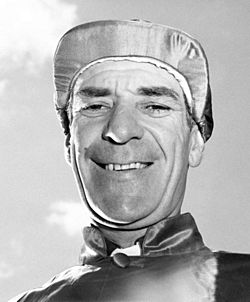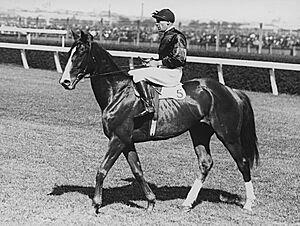Darby Munro facts for kids

Darby Munro, Randwick 1952
|
|
| Personal information | |
|---|---|
| Birth name | David Hugh Munro |
| Nickname(s) | Brown Bomber, the Demon, the Coon |
| Nationality | Australian |
| Born | 5 March 1913 Caulfield, Victoria, Australia |
| Died | 3 April 1966 (aged 53) Sydney, New South Wales, Australia |
| Alma mater | Marist Brothers' College, Randwick |
| Occupation | Jockey |
Darby Munro was a famous Australian jockey. His full name was David Hugh Munro. He was born on March 5, 1913, in Caulfield, Victoria. He passed away on April 3, 1966. People knew him by cool nicknames like "the Demon" and the "Brown Bomber." Darby was an Indigenous Australian. He achieved amazing success in horse racing. He won the super important Melbourne Cup three times!
Contents
Early Life and Training
Darby Munro went to school at Marist Brothers' College in Randwick. He started learning to be a jockey when he was about 10 years old. He trained with his father, Hugh Munro. Some say he was discovered by a famous trainer named Jeremiah Carey. Darby's first race was in May 1927. He quickly became known as one of the best jockeys around.
A Star Jockey's Career
Darby Munro became very popular in May 1927. He won the Prospect Handicap race. He even beat his famous brother, Jim Munro, in that race! Soon, top trainers wanted Darby to ride their horses. These trainers included Jackson "Jack" Holt and Peter Riddle.
Darby's Riding Style
Darby was known for his strong and energetic riding. He was especially good at winning races in a close finish. Unlike many other jockeys, he didn't play golf. Instead, he stayed fit by riding horses and swimming. He loved swimming! Even though he rode with lots of energy, he rarely fell off his horse. He was almost never seriously hurt.
Darby was invited to ride in England many times. But he always chose to stay in Australia. He was famous for his serious "poker face." This meant it was hard to tell what he was thinking. Some people loved him and cheered his wins. Others might have booed when he didn't win. Many fans thought he was Australia's greatest jockey. Everyone agreed he was certainly the most exciting!
Later Years and Challenges
Darby Munro even appeared in a movie! He played himself in the 1941 comedy film Racing Luck.
He faced some challenges during his career. In 1941, he was unable to ride for six months. He also joined the Second AIF (the Australian army) in 1942. He served until 1944 when he left due to health reasons. Later, he was unable to ride for two years after a race in Caulfield. In 1953, he rode in races in California and France.
Retirement and Legacy
Darby Munro retired from racing in 1955. In his later years, he had some health problems. He passed away on April 3, 1966, due to an illness. He was buried in the Catholic section of Randwick cemetery.
Darby Munro left a big mark on Australian horse racing:
- In 1981, a drawing of Darby Munro was put on an Australian stamp. This stamp was issued by Australia Post.
- In 2001, his name was added to the Australian Racing Hall of Fame. This is a special place for the best people in Australian racing history.
Major Race Wins
Darby Munro won many important races during his career. Here are some of his most famous victories:
- Melbourne Cup: Peter Pan (1934), Sirius (1944), Russia (1946). Only two other jockeys have won the Melbourne Cup more times!
- W S Cox Plate: Rogilla (1933), Young Idea (1937), Mosaic (1939), Beau Vite (1941), Hydrogen (1952)
- A.J.C. Derby/Australian Derby: Hall Mark (1933), Nuffield (1938), Reading (1939), Main Topic (1942)
- V.R.C. Derby/Victoria Derby: Hall Mark (1933), Hydrogen (1951)
- Doncaster Handicap: Venetian Lady (1930), Mildura (1940)
- Epsom Handicap: Modulation (1944), Shannon (1946)
- Sydney Cup: Mosaic (1940), Abspear (1943), Veiled Threat (1944)
He also won many other big races, including:
- All Aged Stakes: Katanga (1944), San Domenico (1952)
- Chelmsford Stakes: Rogilla (1933) and (1934)
- Chipping Norton Stakes: Reading (1940), Katanga (1944) and (1945)
- Colin Stephen Quality Handicap: Rogilla (1933) and (1934), Beau Vite (1941), Katanga (1942) and (1943)
- George Main Stakes: Shannon (1946) and (1947)
- Kings Cup (now Queen Elizabeth Stakes (ATC)): Rogilla (1934), Allunga (1937), Old Rowley (1938), Mosaic (1940), Katanga (1944), Russia (1947), Aristocrat (1952)
- Melbourne Stakes (now LKS Mackinnon Stakes): Rogilla (1933), Peter Pan (1934), Beau Vite (1941)
- AJC St Leger: Reading (1940), Hydrogen (1952)
- AJC Sires' Produce Stakes: Dark Sky (1934), Reading (1939)
- VRC St Leger: Reading (1940)
- Warwick Stakes: Rogilla (1935), Allunga (1937), Beaulivre (1940), Katanga (1943), Removal (1945), Tarien (1954)




